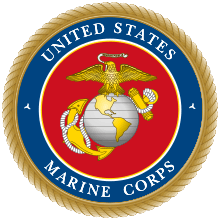V Amphibious Corps
The V Amphibious Corps (VAC) was a formation of the United States Marine Corps which was composed of the 3rd, 4th and 5th Marine Divisions in World War II. The three divisions were the amphibious landing force for the United States Fifth Fleet and were notably involved in the battles for Tarawa, Saipan, and Iwo Jima, during the war. The V Amphibious Corps was commanded by General Holland 'Howlin Mad' Smith followed by General Harry Schmidt.
| V Amphibious Corps | |
|---|---|
 | |
| Active | 25 August 1943 – 15 February 1946 |
| Allegiance | |
| Branch | |
| Type | Marine Air-Ground Task Force |
| Role | Expeditionary combat force |
| Part of | Inactive |
| Engagements | World War II * Battle of Tarawa * Battle of Makin * Battle of Kwajalein * Battle of Eniwetok * Battle of Saipan * Battle of Tinian * Battle of Iwo Jima |
History
The V Amphibious Corps (formerly Amphibious Corps, Pacific Fleet; ACPF) was formed on 25 August 1943 at Camp Elliot, California. In September 1943, it moved to Pearl Harbor, Hawaii.
Structure
The structure of a United States Marine Corps' amphibious corps by 1945, was broken down into four major subordinate commands with each of them having numerous sub-elements:
- The first major element of the Corps was three reinforced Marine infantry divisions.
- The second was the Corps artillery, which was composed of a field artillery group made of three battalions of 155mm howitzers, three battalions of 155mm guns, and an Antiaircraft Artillery Group made of three antiaircraft artillery battalions.
- The third was the Amphibian Tractor Group, which was made up of four amphibian tractor battalions and an armored amphibian tractor battalion.
- The fourth was the Corps Troops, which was composed of a headquarters and service battalion, administrative command, signal battalion, medical battalion, motor transport battalion, engineer battalion, reconnaissance battalion, and military police battalion.[1]
Subordinate units
The US Marine Corps and US Army commands that served under the V Amphibious Corps in World War II include:[2]
- Marine Corps
- 2nd Marine Division
- 3rd Marine Division
- 4th Marine Division
- 5th Marine Division
- 22nd Marine Regiment
- Amphibious Reconnaissance Battalion [formerly "Company"]
- Army
Command and Staff
Corps Commanders
- General Holland M. Smith: 25 August 1943 – 11 July 1944
- General Harry Schmidt: 12 July 1944 – 15 February 1946 (Deactivation)
Chiefs of Staff
- Brigadier General Graves B. Erskine: August 1943 - August 1944
- Brigadier General William W. Rogers: August 1944 - December 1945
- Brigadier General Dudley S. Brown: December 1945 - February 1946
Corps Artillery
- Brigadier general Thomas E. Bourke
- Colonel John S. Letcher (July 1944 - June 1945)
Personnel Officers
- Lieutenant Colonel Albert F. Metze
- Colonel David A. Stafford (October 1944 - February 1946)
Intelligence Officers
- Lieutenant Colonel St. Julien R. Marshall: August 1943 - October 1944
- Colonel Thomas R. Yancey (USA)
Operations Officers
- Colonel John C. McQueen (August 1943 - August 1944)
- Colonel Edward A. Craig (August 1944 - April 1945)
- Colonel Walter W. Wensinger (April 1945 - February 1946)
Logistics Officers
- Colonel Raymond E. Knapp (August 1943 - April 1944)
- Colonel William F. Brown
Unit awards
A unit citation or commendation is an award bestowed upon an organization for the action cited. Members of the unit who participated in said actions are allowed to wear on their uniforms the appropriate ribbon of the awarded unit citation. V Amphibious Corps has been awarded the following:[3]
| Streamer | Award | Year(s) | Additional Info |
|---|---|---|---|
| Presidential Unit Citation Streamer | 1945 | Iwo Jima | |
| Navy Unit Commendation Streamer | 1945 | Iwo Jima | |
| Asiatic-Pacific Campaign Streamer with four Bronze Stars | 1943-1946 | Gilbert Islands, Marshall Islands, Marianas Islands, Iwo Jima | |
| World War II Victory Streamer | 1943–1946 | Pacific War |
See also
References
- Rottman USMC WWII OOB, p.102.
- Rottman USMC WWII OOB, p. 111.
- "Archived copy". Archived from the original on 8 May 2013. Retrieved 16 November 2013.CS1 maint: archived copy as title (link)
Sourcces

- Arens, Major Mark P., USMCR (1995). "Chapter 2: V Amphibious Corps". V [Marine] Amphibious Corps Planning for Operation Olympic and the Role of Intelligence in Support of Planning. Marine Corps Staff and Command College. Retrieved 13 May 2007.
Written in fulfillment of a requirement for the Marine Corps Staff and Command College.
- Rottman, Gordon L. (2002). U.S. Marine Corps World War II Order of Battle – Ground and Air Units in the Pacific War, 1939 – 1945. Greenwood Press. ISBN 0-313-31906-5.
Further reading
- Drez, Ronald J. and Stephen E. Ambrose (2003). Twenty-Five Yards of War: The Extraordinary Courage of Ordinary Men in World War II. Hyperion. p. 227. ISBN 978-0-7868-8668-5.
This three division Marine force was the largest ever committed to a single battle in the history of the Corps. It would bear the title V Amphibious Corps or VAC.
- Rottman, Gordon L. and Mike Chappell (1995). US Marine Corps 1941–45. Osprey Publishing. ISBN 1-85532-497-0.
